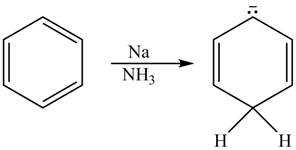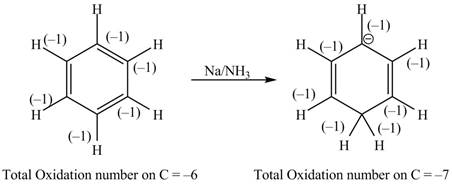
(a)
Interpretation:
The reaction,
Concept introduction:
A redox reaction is a type of reaction in which one reacting species gets oxidize and other reacting species is reduced. The exchange of electron takes place between the reacting species. Water molecules and protons can be used to
Answer to Problem 10.26P
The reaction,
Explanation of Solution
The given reaction is shown below.
The reactant and products with an oxidation number of atoms are shown below.

Figure 1
The oxidation number of reactant is lower than the oxidation number of the product. Therefore, the reaction is an oxidation reaction.
The number of electrons transfer in the reaction is given by the expression as shown below.
Where,
•
•
Substitute the values of
Therefore, the number of electrons transferred in the reaction is
The number of electrons transferred in the oxidation reaction is
(b)
Interpretation:
The given reaction is to be classified as an oxidation, a reduction, or neither. The number of electrons transferred in the reaction is to be stated when the corresponding reaction is oxidation or reduction.
Concept introduction:
A redox reaction is a type of reaction in which one reacting species gets oxidize and other reacting species is reduced. The exchange of electron takes place between the reacting species. Water molecules and protons can be used to balance a redox
Answer to Problem 10.26P
The given reaction is classified as oxidation reaction. The number of electrons transferred in the reaction is
Explanation of Solution
The given reaction is shown below.

Figure 2
The reactant and products with oxidation number of atoms are shown below.

Figure 3
The oxidation number of reactant is lower than the oxidation number of the product. Therefore, the reaction is an oxidation reaction.
The number of electrons transfer in the reaction is given by the expression as shown below.
Where,
•
•
Substitute the values of
Therefore, the number of electrons transferred in the reaction is
The number of electrons transferred in the oxidation reaction is
(c)
Interpretation:
The reaction,
Concept introduction:
A redox reaction is a type of reaction in which one reacting species gets oxidize and other reacting species is reduced. The exchange of electron takes place between the reacting species. Water molecules and protons can be used to balance a redox chemical reaction in the acidic medium.
Answer to Problem 10.26P
The reaction,
Explanation of Solution
The given reaction is shown below.
The reactant and products with oxidation number of atoms are shown below.

Figure 4
The oxidation number of reactant is higher than the oxidation number of the product. Therefore, the reaction is the reduction reaction.
The number of electrons transfer in the reaction is given by the expression as shown below.
Where,
•
•
Substitute the values of
Therefore, the number of electrons transferred in the reaction is
The number of electrons transferred in the reduction reaction is
(d)
Interpretation:
The given reaction is to be classified as an oxidation, a reduction, or neither. The number of electrons transferred in the reaction is to be stated when the corresponding reaction is oxidation or reduction.
Concept introduction:
A redox reaction is a type of reaction in which one reacting species gets oxidize and other reacting species is reduced. The exchange of electron takes place between the reacting species. Water molecules and protons can be used to balance a redox chemical reaction in the acidic medium.
Answer to Problem 10.26P
The given reaction is to be classified as oxidation reaction. The number of electrons transferred in the reaction is
Explanation of Solution
The given reaction is shown below.

Figure 5
The reactant and products with oxidation number of atoms are shown below.

Figure 6
The oxidation number of reactant is lower than the oxidation number of the product. Therefore, the reaction is an oxidation reaction.
The number of electrons transfer in the reaction is given by the expression as shown below.
Where,
•
•
Substitute the values of
Therefore, the number of electrons transferred in the reaction is
The number of electrons transferred in the oxidation reaction is
(e)
Interpretation:
The given reaction is to be classified as an oxidation, a reduction, or neither. The number of electrons transferred in the reaction is to be stated when the corresponding reaction is oxidation or reduction.
Concept introduction:
A redox reaction is a type of reaction in which one reacting species gets oxidize and other reacting species is reduced. The exchange of electron takes place between the reacting species. Water molecules and protons can be used to balance a redox chemical reaction in the acidic medium.
Answer to Problem 10.26P
The given reaction is to be classified as oxidation reaction. The number of electrons transferred in the reaction is
Explanation of Solution
The given reaction is shown below.

Figure 7
The reactant and products with oxidation number of atoms are shown below.

Figure 8
The oxidation number of reactant is lower than the oxidation number of product. Therefore, the reaction is oxidation reaction.
The number of electrons transfer in the reaction is given by the expression as shown below.
Where,
•
•
Substitute the values of
Therefore, the number of electrons transferred in the reaction is
The number of electrons transferred in the oxidation reaction is
(f)
Interpretation:
The given reaction is to be classified as an oxidation, a reduction, or neither. The number of electrons transferred in the reaction is to be stated when the corresponding reaction is oxidation or reduction.
Concept introduction:
A redox reaction is a type of reaction in which one reacting species gets oxidize and other reacting species is reduced. The exchange of electron takes place between the reacting species. Water molecules and protons can be used to balance a redox chemical reaction in the acidic medium.
Answer to Problem 10.26P
The given reaction is to be classified as neither
Explanation of Solution
The given reaction is shown below.

Figure 9
The reactant and products with an oxidation number of atoms are shown below.

Figure 10
The oxidation number of reactant is equal to the oxidation number of the product. Therefore, the reaction is neither oxidation reaction nor reduction reaction.
The compound neither oxidized nor reduced.
(g)
Interpretation:
The given reaction is to be classified as an oxidation, a reduction, or neither. The number of electrons transferred in the reaction is to be stated when the corresponding reaction is oxidation or reduction.
Concept introduction:
A redox reaction is a type of reaction in which one reacting species gets oxidize and other reacting species is reduced. The exchange of electron takes place between the reacting species. Water molecules and protons can be used to balance a redox chemical reaction in the acidic medium.
Answer to Problem 10.26P
The given reaction is to be classified as a reduction reaction. The number of electrons transferred in the reaction is
Explanation of Solution
The given reaction is shown below.

Figure 11
The reactant and products with oxidation number of atoms are shown below.
\
Figure 12
The oxidation number of reactant is higher than the oxidation number of the product. Therefore, the reaction is reduction reaction.
The number of electrons transfer in the reaction is given by the expression as shown below.
Where,
•
•
Substitute the values of
Therefore, the number of electrons transferred in the reaction is
The number of electrons transferred in the reduction reaction is
Want to see more full solutions like this?
Chapter 10 Solutions
EBK ORGANIC CHEMISTRY STUDY GUIDE AND S
- Synthesize N-Methylcyclohexylamine from cyclohexanol using the necessary organic or inorganic reagents. Draw the structures of the compounds.arrow_forwardSynthesize N-Methylcyclohexylamine from cyclohexanol using the necessary organic or inorganic reagents. Draw the structures of the compounds.arrow_forwardIf possible, please provide the formula of the compound 3,3-dimethylbut-2-enal.arrow_forward
- Synthesize 1,4-dibromobenzene from acetanilide (N-phenylacetamide) using the necessary organic or inorganic reagents. Draw the structures of the compounds.arrow_forwardIndicate the products obtained by mixing (3-oxo-3-phenylpropyl)triphenylphosphonium bromide with sodium hydride.arrow_forwardWe mix N-ethyl-2-hexanamine with excess methyl iodide and followed by heating with aqueous Ag2O. Indicate the major products obtained.arrow_forward
- Indicate the products obtained by mixing acetophenone with iodine and NaOH.arrow_forwardIndicate the products obtained by mixing 2-Propanone and ethyllithium and performing a subsequent acid hydrolysis.arrow_forwardIndicate the products obtained if (E)-2-butenal and 3-oxo-butanenitrile are mixed with sodium ethoxide in ethanol.arrow_forward
- Question 3 (4 points), Draw a full arrow-pushing mechanism for the following reaction Please draw all structures clearly. Note that this intramolecular cyclization is analogous to the mechanism for halohydrin formation. COH Br + HBr Brarrow_forwardIndicate the products obtained if 2,2-dimethylpropanal and acetaldehyde are mixed with sodium ethoxide in ethanol.arrow_forwardIndicate the products obtained if 2,2-dimethylpropanal and acetaldehyde are reacted with sodium ethoxide in ethanol.arrow_forward
 Chemistry: The Molecular ScienceChemistryISBN:9781285199047Author:John W. Moore, Conrad L. StanitskiPublisher:Cengage Learning
Chemistry: The Molecular ScienceChemistryISBN:9781285199047Author:John W. Moore, Conrad L. StanitskiPublisher:Cengage Learning General Chemistry - Standalone book (MindTap Cour...ChemistryISBN:9781305580343Author:Steven D. Gammon, Ebbing, Darrell Ebbing, Steven D., Darrell; Gammon, Darrell Ebbing; Steven D. Gammon, Darrell D.; Gammon, Ebbing; Steven D. Gammon; DarrellPublisher:Cengage Learning
General Chemistry - Standalone book (MindTap Cour...ChemistryISBN:9781305580343Author:Steven D. Gammon, Ebbing, Darrell Ebbing, Steven D., Darrell; Gammon, Darrell Ebbing; Steven D. Gammon, Darrell D.; Gammon, Ebbing; Steven D. Gammon; DarrellPublisher:Cengage Learning

